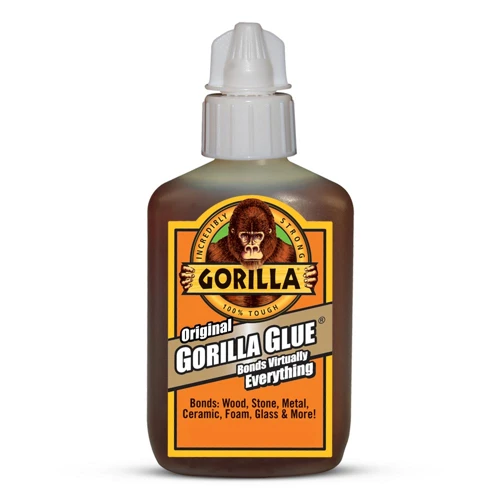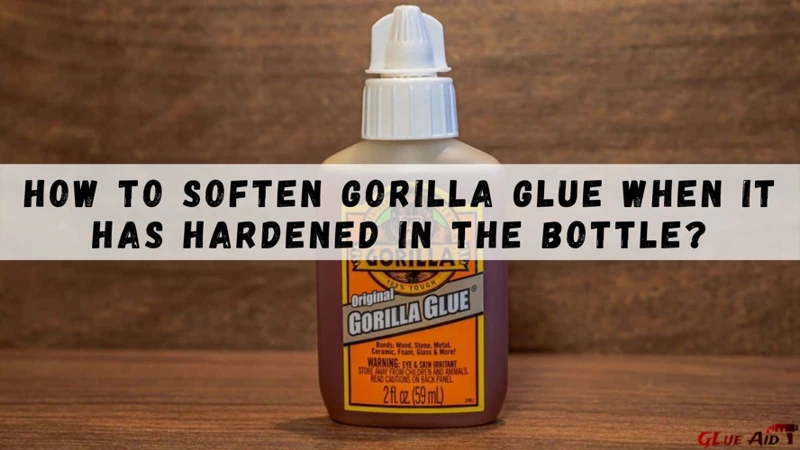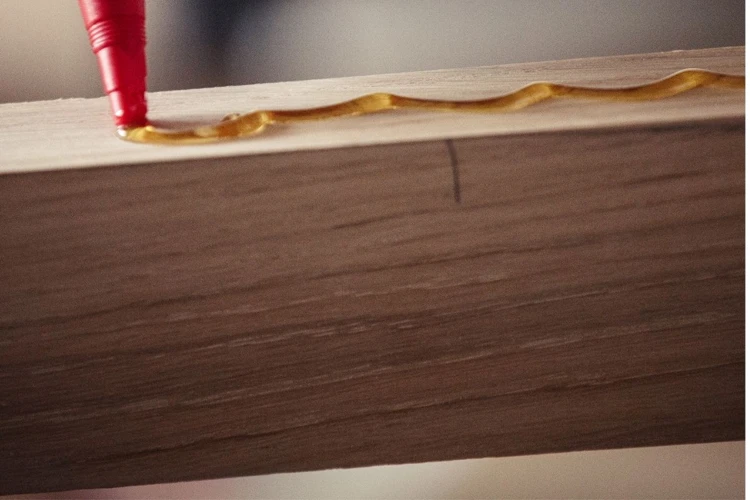Have you ever found yourself struggling to work with Gorilla Glue due to its tendency to harden quickly? Maybe you’ve even had to throw away a whole container of glue because it became unusable after just a few uses. If so, don’t worry – you’re not alone. Many DIYers and professionals alike have faced the same problem. Fortunately, there are several methods to soften Gorilla Glue and make it usable again. In this article, we’ll explore these methods and provide you with tips on how to prevent Gorilla Glue from hardening in the first place. So, if you’re tired of wasting money on new containers of Gorilla Glue, read on to learn how to soften it and extend its lifespan.
What is Gorilla Glue?
Gorilla Glue is a popular and high-performance adhesive that offers an exceptionally strong bond. But, before discussing how to soften Gorilla Glue, it’s important to understand what it is and how it works. Gorilla Glue is a polyurethane-based adhesive that creates a strong bond by reacting with moisture, and it’s known for its versatility and durability. This adhesive comes in different types, each suitable for different materials and purposes. To learn more about types of Gorilla Glue and their specific applications, follow this link on how to use Gorilla Glue pen.
Types of Gorilla Glue
Gorilla Glue is a popular and strong adhesive that is used to bond different materials together. It comes in various types and each type has distinctive features and uses. Here are some types of Gorilla Glue that you might encounter:
- Gorilla Super Glue: This is a fast-drying adhesive that is ideal for small projects and repairs. It bonds in just 10-30 seconds and can be used on various surfaces, including metal, plastic, and wood.
- Gorilla Epoxy: This type of glue is a two-part adhesive that consists of a resin and a hardener. When mixed together, it creates a strong and waterproof bond. It is perfect for repairing damaged objects or creating new ones.
- Gorilla wood glue: This is a PVA-based adhesive that is specifically designed for woodworking. It dries clear, is sandable, and can be painted or stained. It is ideal for bonding soft and hardwoods, particleboard, and MDF.
- Gorilla construction adhesive: This is a heavy-duty adhesive that is specially formulated for construction projects. It can bond a variety of surfaces, including brick, metal, concrete, and wood. It is waterproof and can withstand extreme temperatures and weather conditions.
- Gorilla clear grip: This is a crystal clear adhesive that is perfect for bonding glass, plastic, and metal. It dries clear and is paintable, making it ideal for use in crafts and DIY projects.
No matter the type of Gorilla Glue you are using, it is essential to follow the manufacturer’s instructions carefully for best results. In case you need to modify the application of the glue, such as thinning it, or if you are curious about how to make Gorilla Glue on your own, be sure to visit How to Thin Gorilla Glue or How to Make Gorilla Glue guides.
Why Soften Gorilla Glue?
Gorilla Glue is known for being one of the strongest and most durable adhesives. However, sometimes, you may need to soften Gorilla Glue after it has already dried or hardened. This could be because you made a mistake during the application process, or the glue has accidentally stuck to surfaces it shouldn’t have. Whatever the reason, softening Gorilla Glue can help you to remove it safely without damaging the surfaces underneath. Softening the glue can also make it easier to work with if you need to trim or adjust it after application. Without the proper technique, attempting to remove hardened Gorilla Glue can be difficult and may result in damage to your materials. It is important to learn how to soften Gorilla Glue properly.
How to Soften Gorilla Glue?
Finding yourself with hardened Gorilla Glue can be frustrating, especially if you are in the middle of a project or just beginning one. Knowing how to soften Gorilla Glue and make it workable is essential for any DIY enthusiast or professional. There are several methods you can use to soften Gorilla Glue, and we’ll explore them in the following sections. But first, let’s briefly discuss what Gorilla Glue is and why it’s important to know how to soften it. If you’re curious about some other aspects of Gorilla Glue, you can also check out how strong Gorilla Glue is or why it’s so strong.
Method 1: Applying Heat
One effective way to soften Gorilla Glue is using heat. This method can be particularly useful if your Gorilla Glue has hardened around a surface, making it difficult to remove. However, this method is not recommended for softening glue on delicate or heat-sensitive surfaces, as it can cause damage.
The following steps describe how to soften Gorilla Glue using heat:
| Step 1 | Preheat an oven to 200°F (93°C). |
| Step 2 | Place the object with the hardened glue into the oven for about 10 minutes. |
| Step 3 | Check the glue every 2-3 minutes. The glue will start to soften and become more pliable as it heats up. |
| Step 4 | Remove the object from the oven and use a scraper or sandpaper to remove the glue. |
It is important to note that although this method can be effective, it should only be used on surfaces that can withstand the heat. If the glue is not completely softening, repeat the process until the desired result is achieved. It is always recommended to wear gloves and work in a well-ventilated area when working with Gorilla Glue.
If you are interested in learning more about different types of Gorilla Glue, check out our article on what is the stickiest glue in the world.
Method 2: Applying Solvents
Applying solvents is another effective way to soften Gorilla Glue. The solvents can dissolve the bond between the glue and the surface, making it easier to remove. Here are the steps to follow when using solvents:
- Choose the right solvent – acetone is a powerful solvent that works well with Gorilla Glue. You can also use denatured alcohol or rubbing alcohol.
- Get a soft cloth or rag and apply the solvent to it.
- Place the cloth on the glue and let it sit for a few minutes so that the solvent can penetrate the glue and start to soften it.
- After a few minutes, remove the cloth and try to scrape off the glue. If it doesn’t come off easily, apply more solvent and repeat the process.
- Once the glue is removed, clean the surface with soap and water to remove any residue.
It’s important to note that solvents like acetone are harsh chemicals that need to be handled with care. Make sure to wear gloves and use the solvent in a well-ventilated area. Also, avoid using solvents on surfaces that can be damaged by the chemicals.
By following the steps above, you can effectively soften Gorilla Glue using solvents. However, it’s important to note that this method is not suitable for all surfaces. Some materials may be damaged by solvents, so it’s best to test a small area first before using the solvent on the entire surface.
If you want to learn more about Gorilla Glue and its uses, check out our article on what strain is Gorilla Glue 4. Additionally, if you’re interested in learning how to use a Gorilla Glue Pen, check out our article on how to use Gorilla Glue Pen.
Method 3: Sanding and Scraping
When it comes to softening hardened gorilla glue, sanding and scraping is a manual way to break down the adhesive. This method is best for areas that aren’t too large and the glue hasn’t seeped deep into the surface. Here are the steps you need to follow:
- Take a coarse sandpaper, such as 80-grit, and carefully start sanding the hardened glue.
- Try to sand the glue off without applying too much pressure or force. If you press too hard, you can damage the surface you are working on.
- Take a scraper or chisel and gently try to pry off the glue particles.
- For areas where the glue is especially stubborn, a razor blade can be very effective. Be careful when using a razor blade, as they are sharp and can easily slip and cause injury.
- Once you have removed as much glue as possible, use a finer grit sandpaper, such as 120-grit, to smooth out the surface and eliminate any rough patches.
Note: Before attempting this method, be sure to wear protective gear such as work gloves and safety glasses to protect your eyes and skin. If you are working on wood or another porous material, sanding and scraping can leave tiny particles of glue behind. Be sure to remove any traces of adhesive before applying any new glue to the surface.
If you need further guidance on opening a Gorilla glue nozzle, read our step-by-step guide here or to learn about the cost of Gorilla Glue, check out our article here.
Preventing Gorilla Glue from Hardening
Once you’ve mastered the art of softening Gorilla Glue, you might be wondering what you can do to prevent it from hardening again in the future. Keeping Gorilla Glue from hardening requires proper storage and handling. If you take a bit of time to properly store and handle your Gorilla Glue, it will last longer and be ready for use whenever you need it. In this section, we’ll provide some tips to help you keep your Gorilla Glue from hardening too quickly. And if you need help opening a tube of hard Gorilla Super Glue, check out our guide on how to open Gorilla Super Glue.
Tips to Keep Gorilla Glue from Hardening
Keeping Gorilla Glue from hardening is important to keep the glue ready for your next project. Here are some tips to prevent Gorilla Glue from hardening:
| Tip 1: | Store Gorilla Glue in a cool, dry place. This will prevent moisture from getting into the glue and hardening it. |
| Tip 2: | Use a tool to apply the glue instead of your fingers. This will prevent the oils from your skin from getting on the glue and interfere with its setting process. |
| Tip 3: | After using Gorilla Glue, immediately wipe the excess glue off the tip of the bottle and keep it cap tightly sealed. This will prevent air from entering the bottle and hardening the glue. |
| Tip 4: | If you have a big project that requires a large amount of Gorilla Glue, consider purchasing a smaller bottle rather than a larger one. This will prevent the unused glue in the larger bottle from hardening. |
| Tip 5: | Keep Gorilla Glue away from any heat sources, such as direct sunlight, stoves, or heaters. This will prevent the glue from hardening due to the heat. |
By following these simple tips, you can extend the life of Gorilla Glue and ensure that it is always in good working condition for your upcoming projects.
Conclusion
After exploring the different methods of softening Gorilla Glue, it is clear that each method has its own advantages and disadvantages. Applying heat is a quick and effective option, but it can be risky since it can damage the surrounding materials. Solvents can soften the glue without causing damage, but they also pose potential health hazards if not used properly. Lastly, sanding and scraping may be the safest option, but it can be time-consuming and labor-intensive.
It’s important to remember that prevention is key when it comes to Gorilla Glue. Choosing the right type of Gorilla Glue for your project and using it correctly will help prevent it from hardening too quickly. Additionally, storing the glue in a cool, dry place and keeping the cap tightly sealed can help extend its shelf life.
Overall, each method of softening Gorilla Glue has its own advantages and disadvantages. It is important to consider the type of project you are working on and choose the safest and most effective method for you. By taking preventative measures and being careful with your application, you can avoid the hassle of trying to soften hardened Gorilla Glue in the first place.
Frequently Asked Questions
1. Can Gorilla Glue be softened after it has hardened?
Yes, it is possible to soften hardened Gorilla Glue using various methods as explained in this article.
2. What are the different types of Gorilla Glue available in the market?
Gorilla Super Glue, Gorilla Wood Glue, Gorilla Epoxy, and Gorilla Construction Adhesive are some of the popular types of Gorilla Glues.
3. Can heat be used to soften Gorilla Glue?
Yes, applying heat is one of the ways to soften Gorilla Glue.
4. Are solvents such as acetone effective in softening Gorilla Glue?
Yes, with the right technique and precautions, solvents such as acetone can be used to soften Gorilla Glue.
5. Can sanding and scraping be used to soften Gorilla Glue?
Yes, sanding and scraping can help remove and soften hardened Gorilla Glue, especially from surfaces that cannot be heated or exposed to solvents.
6. How can I prevent Gorilla Glue from hardening?
Storing the glue in a cool, dry place, keeping the lid tightly closed, and limiting exposure to air can help prevent Gorilla Glue from hardening.
7. Is it necessary to wear protective gear when using solvents to soften Gorilla Glue?
Yes, protective gear such as gloves, safety glasses, and a respirator should be worn when using solvents to soften Gorilla Glue.
8. Can I use a hairdryer to apply heat to Gorilla Glue?
Yes, a hairdryer can be used to apply heat to Gorilla Glue but it may not be as effective as other methods.
9. How long does it take for Gorilla Glue to harden?
Gorilla Glue usually hardens within 10-20 minutes of application, depending on the type and amount used.
10. Can I reuse partially hardened Gorilla Glue?
No, partially hardened Gorilla Glue is less effective and should not be reused. It is important to use fresh glue for optimal results.


